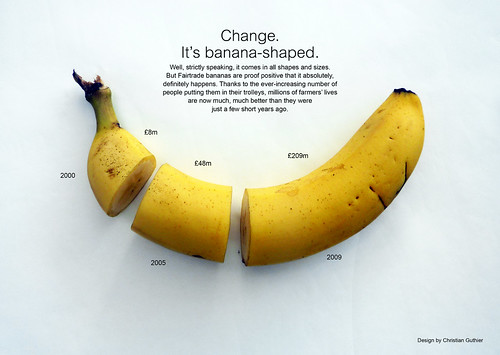Banana Split

flickr photo shared by allispossible.org.uk under a Creative Commons ( BY-NC ) license
Introduction
“The customer is always right!” – claims the dogma of the growth-focused consumer machinery. The consumers know best and can make their own choices. But the consumers are exposed to a myriad of choices in the supermarket - what if the consumer is blindfolded and makes the choices based only on what is good value for money?
We readily buy imported food, as it is significantly cheaper than local food. Yet, most of the time, we don’t have the foggiest idea who these people producing our food are. To most consumers, they are just “ghost people” about whom we know nothing – were they treated fairly while producing the food or providing the raw materials, were they exposed to chemicals, were they paid a decent salary (if at all)? We are connected to people worldwide via the food items we purchase. Many items in our supermarkets are made from raw materials that have been imported from the Global South and many of the workers who produced these raw materials are not paid enough to live a dignified life. But imagine if there was a way to actually guarantee that the food items we purchase come from the hands of healthy, happy people who earn a decent living? This is exactly what the fair trade concept strives to achieve – greater equality at an international scale.
This activity provides an insight into the production of bananas and how profit is split among different groups involved in the production chain.
Activity Type
Group / Experiential
Duration
30 to 45 minutes
Learning Outcomes
To learn how the food chain functions and how profits are distributed
To reflect on how we as consumers can improve the situation
Instructions
Required Materials and Tools:
6 bananas, one for each group in the food chain (5 in total) and one for final demonstration
5 knives, one for each group
cards with role descriptions (optional)
Step-by-Step Instructions:
Tell the group that they are about to play a game that traces the route of the banana – from how it is produced and exported from Latin America to how it reaches the supermarket.
Divide the group into 5 different smaller groups representing links in the food chain (worker, plantation owner, shipper, importer/wholesaler and retailer). Provide instructions on what responsibilities each group has in the chain and the costs involved. If you want to, you can create cards with details about each role; inspiration for the role you can find in the support material (see "attached support files" below). Each group is given 5 minutes to contemplate what their role entails. Ask each group to think about the costs associated, ex. the banana worker: How many hours does the banana worker put in daily? How much money does the plantation owner spend on pesticides and fertilisers? How much does the importer spend on transportation or importation licence fee? What about the shipper and the price of a cargo ship used to transport the bananas? What other costs do the supermarkets (retailer) have besides the cost of staff?
Ask the participants to imagine that one banana costs 30p. Ask each group to assess how much of that money they would get from each banana sold. Give them 5 minutes to discuss this and prepare arguments, taking into account all the work and resources their role entails.
Each group is given a real banana from which they cut a piece representing their share, as they think is fair to have for their role. Make a new “banana” from the pieces (most likely it will be 2-3 times longer than a normal one)
Each group presents their arguments about their share, which normally leads to a sum over 30p. Start the negotiations, attempting to reach the sum of 30p. The negotiations can take up to 15 min depending on people’s arguments.
In the end, reveal who gets what in the 30-penny banana chain – slice up a new banana to better illustrate the real breakdown (plantation worker – 1p; plantation owner – 6p; shipper - 4,5p; importer/wholesaler – 8,5p and retailer/supermarket – 10p)
Attached Support Files
Resource that inspired the activity
Resources
Reflection
Why do some groups benefit significantly more than others, is this a fair situation?
Who has the power to change things for the better?
Discuss the concept of fair share – what can we do to make sure we are enabling workers in other parts of the world to exercise their universal rights?
Instructions for Submission
Submit a short summary in Moodle of how the youth reacts to this game – were they surprised that the worker gets so little? Are they open to adopting fair trade practices in their lives? Instructions on submission can be found here: Instructions on Submission&Uploading
Instructions for Assessment
Provide feedback to at least one participant that has done this activity. Instructions on providing feedback can be found here: Instructions on Feedback
Author
Creative Commons - ySI4R Content Team (Adapted from a game initially published by Christian Aid)